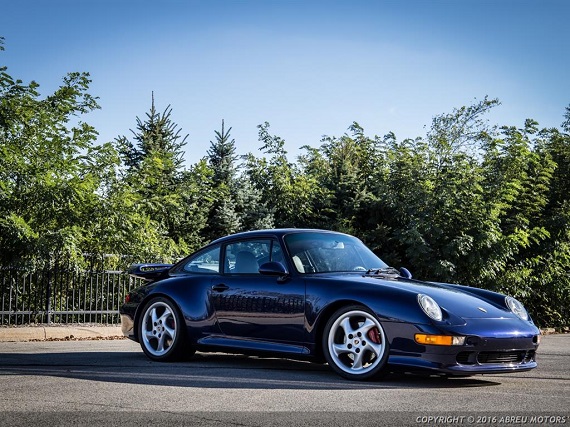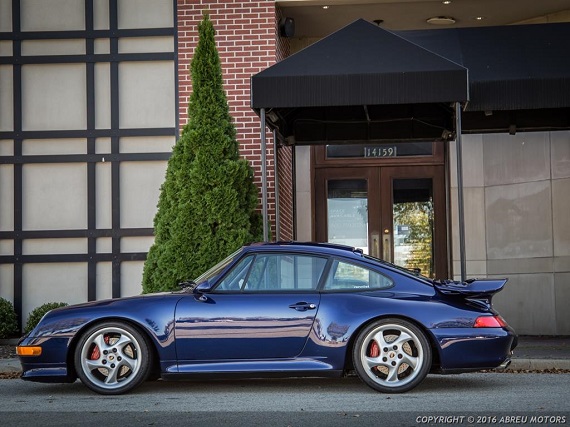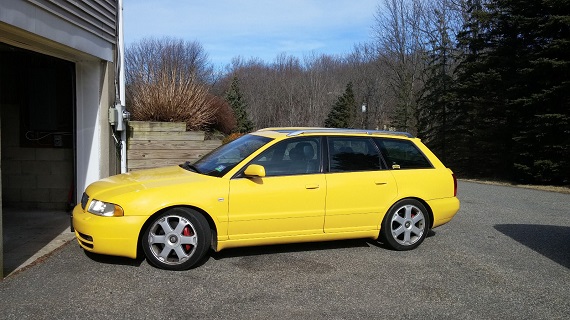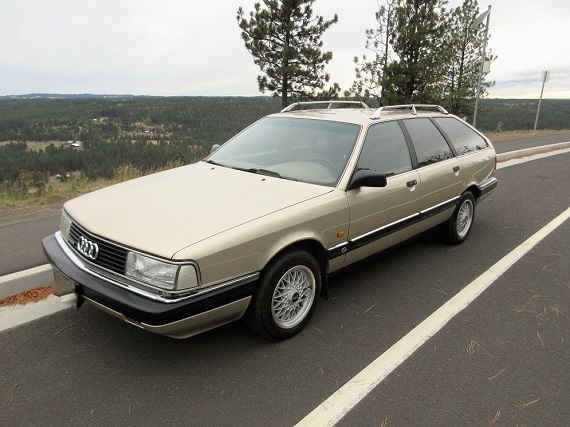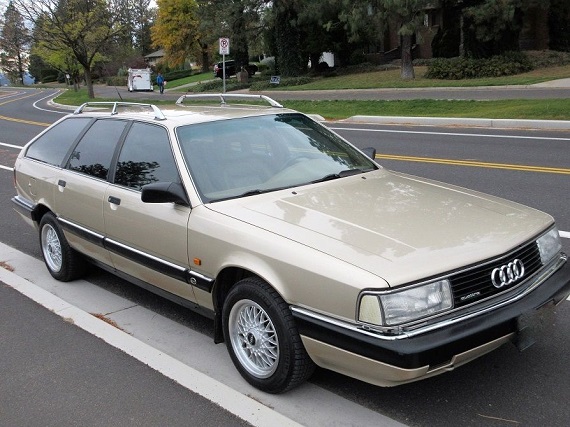I’m always curious when colors change within a marque, especially when they are colors that I particularly like. Here we have an Iris Blue 1996 Porsche 911 Carrera 4S, located in Indiana, with 39,975 miles on it. Iris Blue is a color that we’re fairly familiar with here as it’s been seen on the 3.2 Carrera quite a few times. It’s a really nice shade of blue that veers to the lighter end of the spectrum and one of my favorites available during that time. As should be quite clear, the shade of Iris Blue available for the 993 was quite different, no longer a light blue, but now a dark blue that shows hints of purple when under direct light. The pictures here bear that out fairly well. The full name of the color is Iris Blue Pearl and it is that pearl effect that gives the color is shifting possibilities. I will admit, as someone who loves the original version of the color, that it looks stunning here and seems to work particularly well on the curves of the 993.
German Cars For Sale Blog Posts
I remember a time not that long ago when everyone basically swore off the B5 as being too complicated, too prone to failure, and without enough pizazz. The funny thing was that these judgements were all levied in comparison to the B5’s replacement, the B6. Sure, the BBK 4.2 V8 stuck under the hood was a sonorous revelation of sorts. Gone was the timing belt and the “you’re going to have to replace them at some point” not one, but two turbos stuck in back of the motor that basically necessitated dropping the engine for replacement. The BBK brought nearly 100 more lag-free horses to the party, too, and better-looking interior bits with the promise of more build quality.
What happened?
Well, the reality is that Audi just punted the ball down field. The transition between B5 and B6 marked the real death toll in the long-term Audi for many, as complicated electronic systems really began to outweigh lifetime engineering designs. I love Audis. I really, really do. But it seems like every single system on every single Audi produced after 2002 is so unnecessarily complicated that I can’t imagine how anyone with even a minuscule amount of sense could look at the design and say “Yup, that’ll never go wrong”. They’re engineer’s wet dreams. In the case of the BBK, in addition to eating starters and prodigious amounts of expensive synthetic oil, there is the notorious timing chain guide issue. Since Audi opted to move the timing devices from the front to the back of the motor to fit into the snug B6 engine compartment, pulling the engine apart means taking it out. Finally get it out of the car and pop the covers off, and it looks like a Swiss clock underneath. And there’s one more secret about the B6 4.2 – sure, it’s fast and it feels shouty. But it’s not really that fast for having a 340 horsepower V8 because it weighs two tons unladen. And, turning them up a notch is pretty difficult – you’re basically limited to slapping a supercharger on the motor. As a result, quite a few have turned back a page on history and view the B5 in a much better light today:
CLICK FOR DETAILS: 2001 Audi S4 Avant on eBay
2 Comments I have a love-hate relationship with the G-Wagen, the 4×4 from Mercedes first introduced in 1972 as a military vehicle. I think that the contemporary, blinged-out AMG versions driven by celebrities and Hollywood moguls are an abomination, a crime against motoring humanity. But on the other hand, I’m quite partial to the older, more humble trucks on which they’re based. (I clearly have a thing for boxy old SUVs: I adore vintage Range Rovers, and used to own a Jeep Cherokee XJ, though the less said about that the better.) The original trucks are honest in a way the modern behemoths are not. The G-class was never supposed to be nice to drive, luxurious or a status symbol of wealth and conspicuous consumption. It was a spartan, utilitarian vehicle intended to transport soldiers across inhospitable terrain or, when sold to the public, farmers across boggy marshes.
I have a love-hate relationship with the G-Wagen, the 4×4 from Mercedes first introduced in 1972 as a military vehicle. I think that the contemporary, blinged-out AMG versions driven by celebrities and Hollywood moguls are an abomination, a crime against motoring humanity. But on the other hand, I’m quite partial to the older, more humble trucks on which they’re based. (I clearly have a thing for boxy old SUVs: I adore vintage Range Rovers, and used to own a Jeep Cherokee XJ, though the less said about that the better.) The original trucks are honest in a way the modern behemoths are not. The G-class was never supposed to be nice to drive, luxurious or a status symbol of wealth and conspicuous consumption. It was a spartan, utilitarian vehicle intended to transport soldiers across inhospitable terrain or, when sold to the public, farmers across boggy marshes.
CLICK FOR DETAILS: 1985 Mercedes-Benz 280GE on Hemmings
Comments closed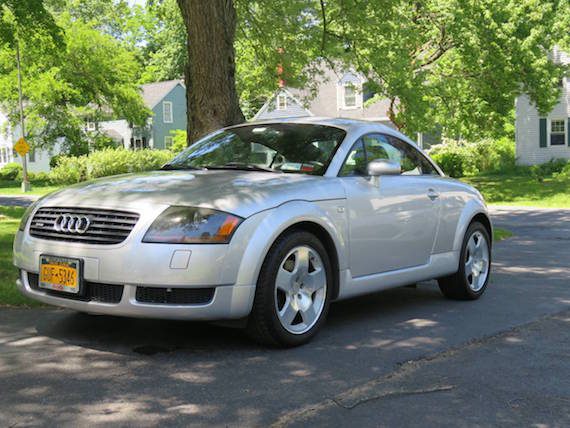 I went to college in London in 2000, about the same time that the first generation TT started to appear on British roads. Because my dorms were in a posh part of town, there were always a few of these parked nearby. The car’s styling struck me as extraordinary. It captured something of the millennial zeitgeist: a minimalist, Bauhaus-esque design that artfully blended lines and curves on the outside, with a bespoke-feeling cockpit on the inside featuring splashes of brushed aluminum and baseball-glove stitching on the leather seats. Back then, I had ambitions to become a lawyer, and this was the perfect car, I thought, for a young single man about town. The perfect yuppie’s car.
I went to college in London in 2000, about the same time that the first generation TT started to appear on British roads. Because my dorms were in a posh part of town, there were always a few of these parked nearby. The car’s styling struck me as extraordinary. It captured something of the millennial zeitgeist: a minimalist, Bauhaus-esque design that artfully blended lines and curves on the outside, with a bespoke-feeling cockpit on the inside featuring splashes of brushed aluminum and baseball-glove stitching on the leather seats. Back then, I had ambitions to become a lawyer, and this was the perfect car, I thought, for a young single man about town. The perfect yuppie’s car.
